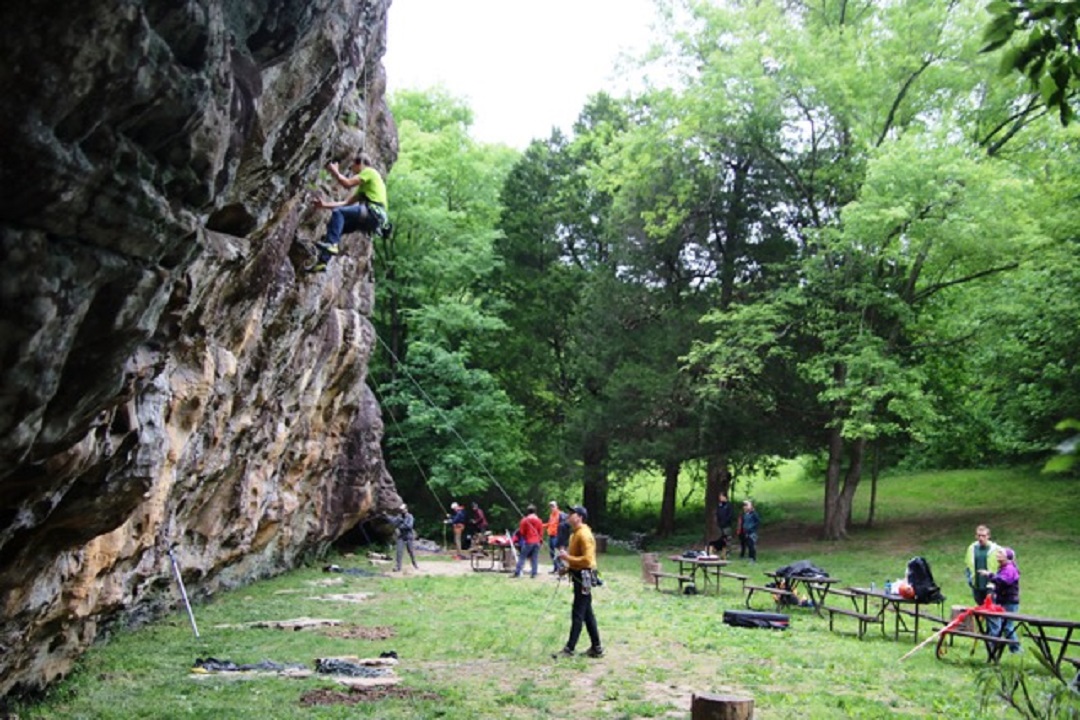Adding one of the country’s first 5.12s to your tick list might be closer than you think, at least in terms of drive time. While most Southern Illinois rock climbing day trips are bound for Holy Boulders or Jackson Falls, neither of the popular locales gets the honor of birthing the cruxy Karma City Limits route. That distinction goes to Giant City State Park in Makanda. The arduous 5.12+, as well as the park’s more moderate climbs, are definitely worth the two-hour drive.
In the 1970s and ’80s, a group of climbers, obsessed with exposing the park’s hidden lines, found possibilities galore. Futuristic pockets coupled with burly moves and feet-cutting dynos comprised their progressive discoveries. But the park’s popularity waned in the advent of sport climbing. As bolts went up at Jackson Falls in neighboring Shawnee National Forest, Giant City, an Illinois State Park, prohibited it.
That is, until 2017. Thanks to the Illinois Climbers Association (ICA), Friends of Giant City State Park, Illinois Department of Natural Resources, and dedicated local climbers like Jeff Frizzell and Eric Ulner, the park’s featured, sandstone classics now welcome a whole new set of senders.
Classic Climbs
Giant City’s grip-friendly sandstone is rich with iron and presents a broad range of features and grades (rope routes: 5.3 to 5.12+, boulder problems: V0 to V10). The 60-second approach to Devil’s Standtable Area or Shelter 1 Bluff may not lead deep into nature’s solitude; however, it does promptly spit you out at the base of 70+ routes and problems.
The single- and multi-pitch lines offer a smorgasbord of chimneys, gullies, roofs, traverses, aretes, slabs, and caves as you crank through the undercut amphitheater, across exposed faces, or up the mushroom-shaped natural table. Here, pockets are perfectly sculpted and jugs differ greatly from the holds of the same name at Jackson Falls. Instead of finger-cramping crimp-fests, Giant City climbing is pumpy and powerful.
“I’ve climbed every route in the park, and there are some amazing sport routes,” said Dave Hug, an ICA board member credited with much of the park’s bolting. “The single-pitch routes are going to give you max bang for your buck because they are tall and the amount of energy you are going to have to put into completing them.”
Giant City is also Hug’s home crag. “I’ve spent a stupid amount of time there over the last 10 years,” he said. “I love it. One thing you’ll find is that a lot of the river limestones seem to feel the same, but when you get to the sandstones, it’s different. Jackson Falls, Giant City, Holy Boulders, it all feels different. The Giant City stuff is my favorite.”
Hug catalogues his favorite routes with a sense of pride — Makanda Layback (5.8), Joe’s Variation (5.9), Graves (5.10+), The Idiot (5.11b), and Crackpot (5.12b) — and he describes each one with the welcoming intention for others to equally enjoy them.
New Meets Old
Giant City’s old school 5.12+, Karma City Limits, could be the climb your tick list craves. The route’s 1976 first assent (FA) belongs to Joe Healy and Jim Foster. At the time, it was considered to be at the outer limit of the climbable. Of course, you may want to trad it like they did, but you don’t have to now.
“It’s…a line we walked under every day for several years before we developed an eye and the experience to even see it, as was the case for a number of those lines,” Healy wrote about the route on Mountain Project. He went on to explain that the send came after seven months of working the crux, injuries, and a few distractions.
Bolting remains a controversial topic, and some are unenthused with its application to Giant City. Others believe that the addition of sport climbing, in this case at Giant City, can balance preservation and accessibility. For better or worse, Giant City State Park’s new hardware embraces the comeback of climbers, particularly of the bolt-clipping variety.
“All the great history, the holds, the faces, had begun to be reclaimed by nature,” Hug said. “We [ICA] believed that the only way to preserve the history and conserve the routes was to bolt them. In return, our hope is that it helps to pass down that rich history and keep generations of new climbers coming back time and time again.”
Author: Corrie Hendrix Gambill is a regular contributor to Terrain Magazine.


Just replacing or adding top anchors was all that was necessary; instead you guys pushed through your own agenda…
Anchors at the cliff top would have provided access to climbs with minimal impact and a more open-ended interpretation for route-finding, but Makanda was grid-bolted.